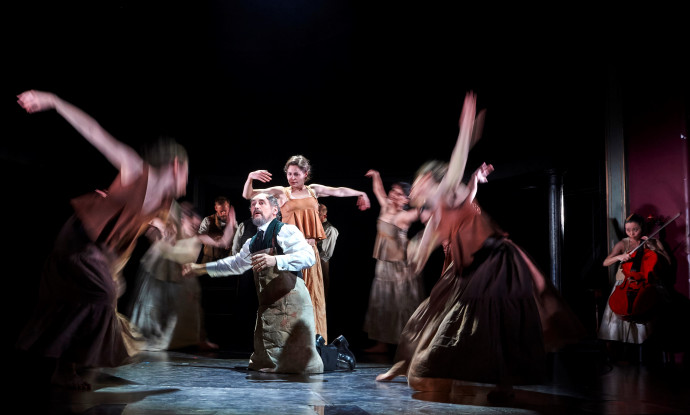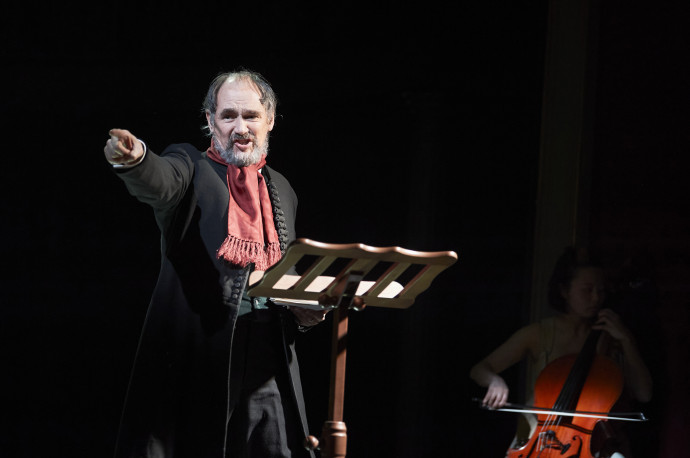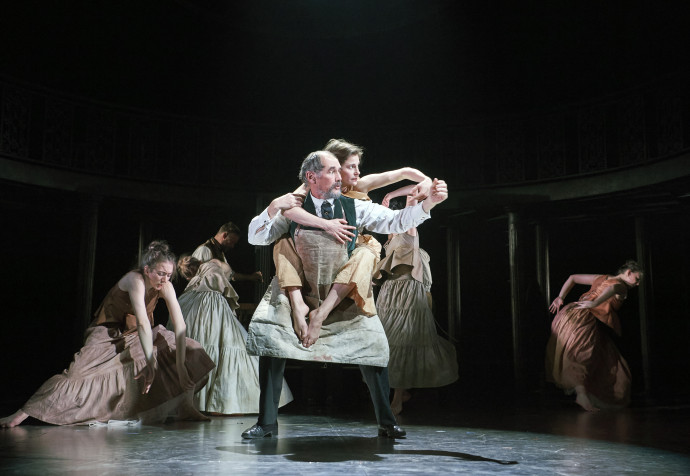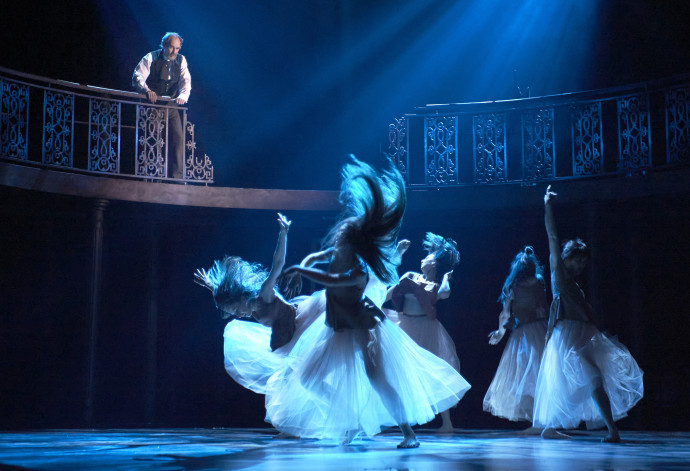Nothing in film will ever match the emotion in the theatre at the end of Dr Semmelweis

"Wash your hands! Wash your hands!" – shouts Academy Award winner Mark Rylance to the audience in his latest play. One of the greatest British actors of our time, most recently seen in the Netflix film Don't Look Up, has written a play about Ignaz Semmelweis, the Hungarian 'saviour of mothers', which recently premiered at the Bristol Old Vic, and in which he also plays the title character.
Widely regarded as one of the greatest British stage actors of our time, Rylance has won two Laurence Olivier Awards (Much Ado About Nothing; Jerusalem) and three Tony Awards (Boeing, Boeing; Jerusalem; Twelfth Night), and was the artistic director of London's world-famous Globe Theatre from 1995 to 2005. He won an Academy Award in 2015 for his performance in Spielberg's The Bridge of Spies, and in recent years he has also appeared in Cristopher Nolan's Dunkirk, Spielberg's Ready Player One, Aaron Sorkin's The Trial of the Chicago 7 and most recently in Adam McKay's Don't Look Up.
The actor started working on Dr Semmelweis in 2015, and planned to stage the play in 2020, but the pandemic forced the premiere to be postponed for almost two years. Covid-19, of course, also gave the play a new relevance. Dr Semmelweis was finally performed for the first time in Bristol in late January, but audiences will not be able to see it for long – it will only run until 19 February, just over four weeks. Tickets were already hard to come by months ago.
The play follows the life of Ignaz Semmelweis from the first mother, who died in his arms, to his death in the Döbling Asylum. How and under what circumstances the Hungarian doctor discovered the cause of puerperal (childbed) fever is told through the mind of Semmelweis, in the form of flashbacks. We follow Semmelweis' life in detail, from his first weeks as a doctor, through his discovery of the cause of puerperal fever and the importance of hand-washing, to his tragic death after failing to persuade the world of medicine about the importance of antisepsis.
Semmelweis struggles simultaneously with the doctors who refuse to believe him and with himself, because he is aware of how many mothers' deaths he himself is responsible for. Mark Rylance is brilliant as the Hungarian doctor, who fights incessantly with himself and others. We meet the clueless, mumbling Semmelweis, but also the one who is screaming at his colleagues at the top of his lungs. There is almost constant movement on stage, thanks to the six dancers, who represent the ghosts of mothers who have died in Semmelweis' arms. There is also a memorable scene in which the doctor performs an autopsy and delivers a baby simultaneously.
The play is a fitting tribute to Ignaz Semmelweis, acknowledging the mistakes, just as much as the heroics of the doctor, who has been undeservedly forgotten outside Hungary.
We watched Dr Semmelweis at the Bristol Old Vic and then spent almost an hour talking with Rylance and the play's co-creators about the struggles of the Hungarian medical pioneer, the creative challenges of the play, and the power of the theatre audience.

Where did the idea come from to make a play about Ignaz Semmelweis? He is far lesser known in Britain than in Hungary.
Mark Rylance: It all started when I came across a book about the life of Semmelweis by Céline (French novelist Louis-Ferdinand Céline). It's a very, very angry book, that painted Semmelweis as a kind of martyr, done in by the medical world he failed to persuade. And then when we started to work on the play, Stephen (Stephen Brown, co-writer of Dr Semmelweis) brought in a book written by an American surgeon called Sherwin B. Nuland, and this was a much more objective historical account. That was where we realised that it wasn't just the authorities who were the problem, but that Semmelweis himself would get very angry and offensive when people didn't understand what he was saying. So these two books were our starting point.
Talk me through the process! How did the play come to life from the initial idea?
MR: Tom (Tom Morris, the director of Dr Semmelweis), who I've known for many years, very nicely asked me if there was something I wanted to do. What were the first steps, Tom?
Tom Morris: I remember having coffee with you in the theatre café at the Young Vic in London. You had sent me the book beforehand, so we talked about it and the conflict in it. From really early on, Mark had the ambition to explore the story in a theatrical form, and to integrate music and dance to the production as well. So with Mark, his wonderful wife (Claire van Kampen), who is a composer, playwright and director; Stephen, Antonia (Antonia Franceschi, the play's choreographer), a string quartet and some dancers, we started experimenting with the story at the National Theatre Studio. We decided from the beginning that in the play we would try to follow Semmelweis' mind and imagination through his journey of discovery.
Stephen Brown: We drew inspiration from many places in that first week. One of the sources I would highlight is the letters that Semmelweis wrote in the last five years or so of his life. The language that he used in those letters is very extraordinary: it is a language of anger, guilt and grief all at once. He writes in a very insulting way about doctors who disagreed with him, calling them murderers and 'medical Neros'; but he also writes about the weight of the deceased. From the very beginning of the play's development, these were all fundamental in understanding Semmelweis' huge and impossible grief at the death of the countless mothers.

In Dr Semmelweis, there is almost constant movement on stage, such as the ghosts of the dead mothers who surround Semmelweis from time to time. Was it decided from the very beginning that movement would play such a prominent role in the play?
TM: To be honest, it was a creative challenge, a creative provocation from Mark. Semmelweis wrote in his letters about carrying the weight of these women. And we wanted to portray Semmelweis' mind with this restless physical energy on stage, with the movement and the dancers.
MR: We really didn't know if it would work. It was a real challenge to think how the dancers and the historical narrative could be woven together. We didn't want them to just be in the background. The voiceless group of six dancers and four musicians…these ten women are a very important part of the play. With them we were able to show that there is a deeper tragedy to what happened to Semmelweis, which is the tragedy of these thousands and thousands of women.
Dr Semmelweis is running only for a few more weeks, despite its overwhelming success. What are the plans for the future of the play? Will audiences be able to see it again in the near future, either in Bristol or in other theatres in the UK, or even abroad?
MR: At Christmastime, with all the fear about the new variant, the January premiere didn't look likely to happen, so it's a blessing that it has been a big success. Tom and I already talked about the future life of the play and it certainly seems a possible thing that we will give it a revival as soon as we can in London. And if I recall correctly, there has been some interest expressed from Hungary as well, from the National Theatre.

Semmelweis isn't the first Hungarian character you have played in your life. Your first movie role, if my research is correct, was in a TV movie about Raoul Wallenberg (Wallenberg: A Hero's Story). What can you recall about the shooting of that film?
MR: That's very good research! Yes, it was a long time ago, 1984, if I remember correctly. You're right, I think it was one of the first times I was on camera. I remember, I got paid a few thousand pounds and I was able to start a co-operative theatre company. We didn't film in Budapest, but in Zagreb, in the old town. Richard Chamberlain was playing Wallenberg and I was cast as a young Hungarian Jewish resistance fighter. I remember reading a book about the terrible history of the Jewish people in Hungary, I think it's called the Black Book. It was one of those nice jobs where you get educated about the world while you are working. I vividly remember that there were lot of Yugoslavians on the set. I became friends with a guy called Max, and I'm still friends with him to this day. He worked as a pyrotechnician on the film, and when I asked him one night during a drinking session why he was doing the film, he said, "to learn about making bombs", because he knew that the war was coming.
Hungarian audiences last saw you in Don't Look Up, which broke viewership records on Netflix. How does it feel to have hundreds of millions of people watching your film? It is a big leap compared to the size of theatre audiences, and even compared to the audiences for your films in cinemas.
MR: It's hard to really understand. Even trying to imagine a million people is hard. I can imagine 80,000 people, I've seen that many people at once with my own eyes, because that's how many people you can fit in a football stadium. What you can sense is that more and more people recognise you on the street. I'm glad so many people are watching the film, but to be honest, it doesn't come anywhere near the experience at the end of Dr Semmelweis, in front of an audience of five hundred people in a 250-year-old theatre. The emotional impact during the play when you hear the audience making noises, or when you hear them being quiet or hear them weeping or laughing… And then the emotion in the room at the end. Nothing in film ever matches that. That feeling of connection that develops between actor and audience in the theatre. That we have gone through something together. And as an artist, of course, I get constant feedback from the audience during performances, even subconsciously. In film, there is no agency like that. Even if I go to a big premiere and the audience enjoys the film. What I'm doing on the screen is not really there, it's just an electronic impression of something that happened many years before. So despite the incredible numbers, the theatre is still more powerful for me. But don't get me wrong, I really enjoy being in films.

You have been in three Spielberg films so far. How did you two meet and become so close?
MR: When we first met, I was a young actor and he wanted me to be in Empire of the Sun. That was a powerful offer, not least because of Steven, but also because both my grandfathers were in Japanese POW camps, one of them in a civilian camp, just like in the film. So I said yes to the offer, but as soon as I said yes, my favourite theatre director in the world, Mike Alfreds, who had a major influence on me, asked me if I wanted to do a season at the National Theatre. It was a very difficult decision, but in the end I chose the theatre. Then, many years later, around 2013-14, I was playing on Broadway with an all-male production of Twelfth Night, where I was playing a woman. Daniel Day-Lewis came to one of the performances and told Spielberg, who is a good friend of his, to come see it, and that's when I met him again in the dressing room after the show. And then the offer came from him to play in Bridge of Spies, and during the shoot we became very good friends, almost brothers. We both share a love of stories. And Steven has such a beautiful, childlike soul, he absolutely falls in love with stories and he wants everyone to like the story in the way he does. He's an amazing person. People don't realise how much support he gives to other filmmakers. He puts enormous energy into other people's works, as well as his own.
Can you tell me anything about one of your upcoming films, The Last Planet, directed by Terrence Malick, in which you will be playing Satan opposite Hungarian actor Géza Röhrig's Jesus?
MR: Oh, yes, I became friends with László (László Nemes Jeles) too, who directed Son of Saul! What a fantastic filmmaker and man László is! I really hope we can do something together one day. I would just adore to work with him! I understand his father (András Jeles) is an important theatre-maker in Hungary. But coming back to Géza, he is a marvelous actor. And in the film, he is a marvelous Jesus Christ. All my scenes are with him, and my job as Satan is to try to tempt him away from his path. It was fun! The movie itself is about Saint Peter. Really though, it's about what happens to a family man when an incredible human being, like a Christ character, comes into his life and pulls him out of his community. I don't know how Terrence will cut it, but on the page the film follows Peter's life up to his eventual crucifixion in Rome.
Dr Semmelweis is at the Bristol Old Vic until 19 February.